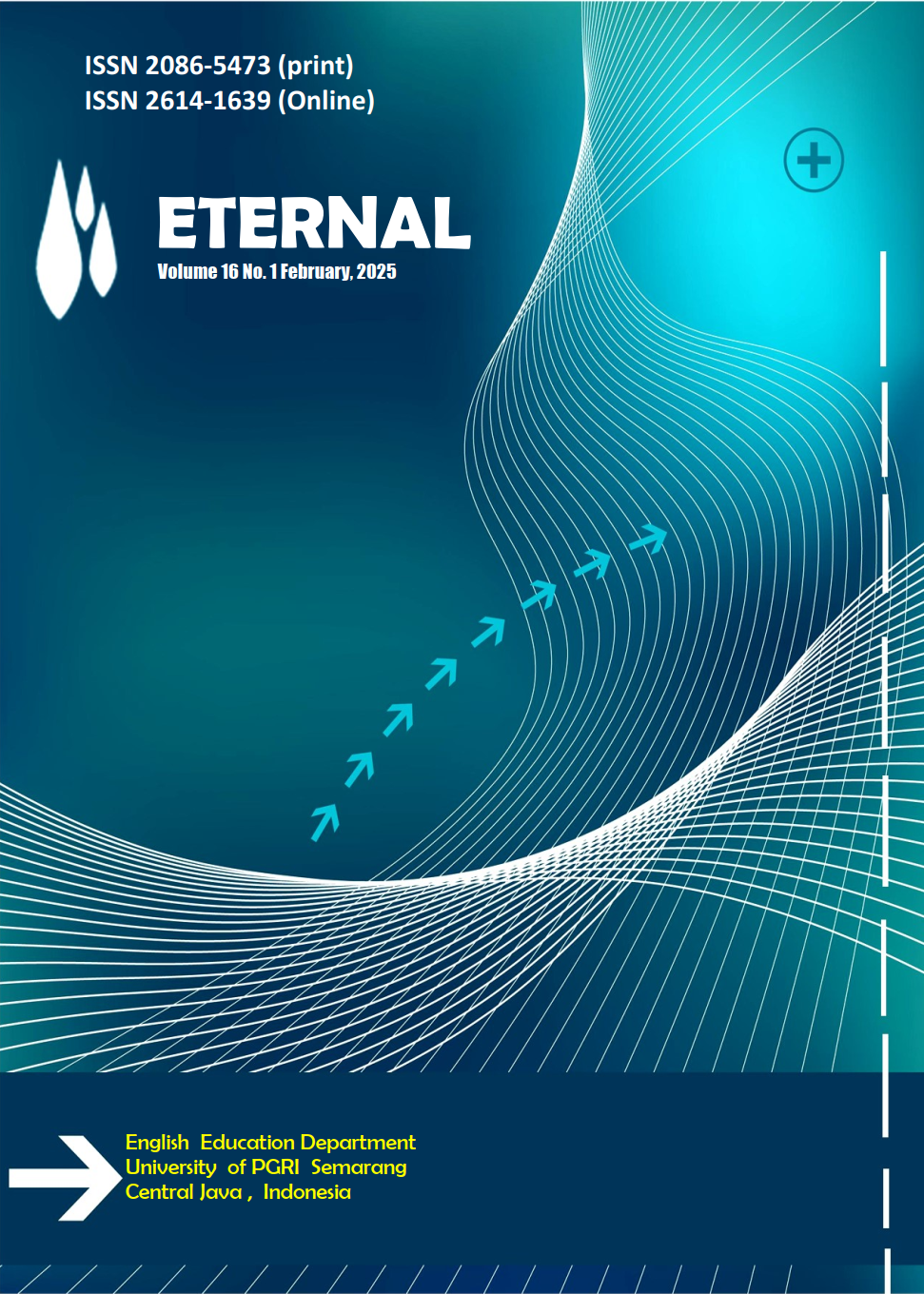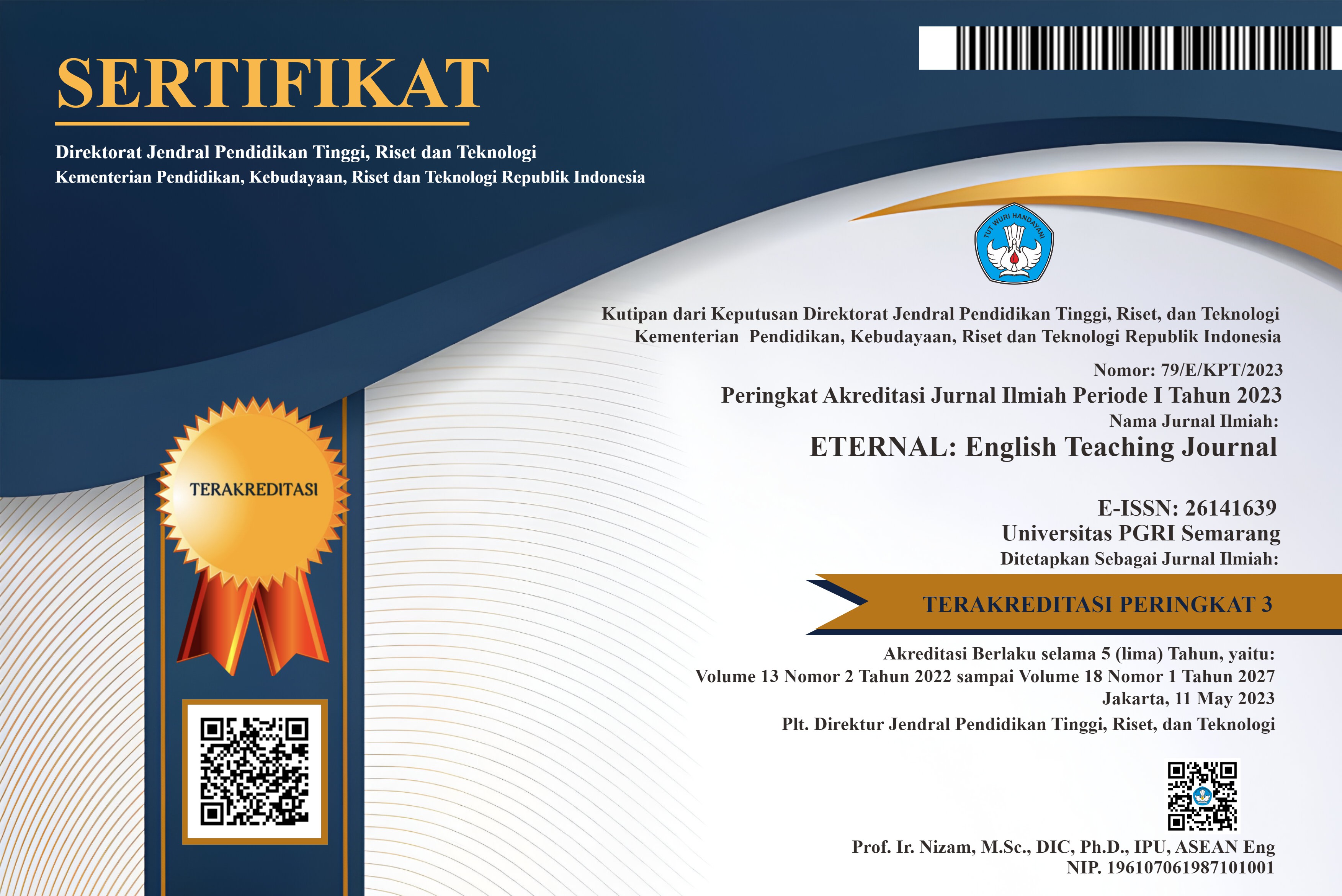Rhetorical Moves of Research Article Abstracts in Linguistics and Language Education with Different Quartile Level
DOI:
https://doi.org/10.26877/eternal.v16i2.1741Keywords:
Abstract, Linguistic and Language Journal, Rhetorical MoveAbstract
Writing an abstract in a research article is very important. The existence of abstract is compulsory in a research article. It is a research summary that must be attached and presented with the article. This study aims to identify moves and the most common pattern in RA abstracts in linguistic and language journals with different quartiles level. By using descriptive qualitative method, eighty RA abstracts of linguistic and language education journals with different quartile level were extracted from eight journals. The result finding; 1) Move 2 (Aim/Purpose) exists in seventy RA abstracts, Move 3 (Method) is present in sixty two RA abstracts, and Move 4 (Finding/Result) appears in Seventy Eight RA abstracts. In contrast, Move 1 (Introduction) is found in only 50 RA abstracts, and Move 5 (Conclusion) appears in 31 RA abstracts. 2) Q1 journal have the most frequent move, indicating a more comprehensive and detailed structure in their abstracts. In contrast, journals in lower quartiles, such as Q3 and Q4, often feature abstracts with fewer moves. As this study focuses only on the rhetorical move and pattern of RA abstract in field of linguistic and language journal with different quartile level, future research should conduct a comparative study and language features of the RA abstract in the field of across discipline with different quartile level.
References
Amnuai, W. (2019). Analyses of rhetorical moves and linguistic realizations in accounting research article abstract published in international and Thai-based journals. SAGEOpen, 1–9. https://doi.org/https://doi.org/10.1177/2158244018822384
Arsyad, S. (2014). The discourse structure and linguistic features of research article abstract in English by Indonesian academics. Asian ESP, 10(2), 191–224.
Arsyad, S. (2021). Rhetorical Structure And Linguistic Features Of Abstracts: A Comparative Study Of Local, National And International Journals In English Education Written By Indonesian Authors. Jurnal Pendidikan Bahasa, Sastra, Dan Seni, 22(1), 1–16.
Ashofteh, Z., Shirvan, M. E., & Golparvar, S. E. (2020). The move structure of abstracts in applied linguistics research articles in light of the distribution and functions of metadiscourse markers. Journal of Language and Linguistic Studies, 16(4), 2077–2096. https://doi.org/10.17263/JLLS.851035
Behnam, B., & Golpour, F. (2014). A genre analysis of english and Iranian research articles abstracts in applied linguistics and mathematics. International Journal of Applied Linguistics and English Literature, 3(5), 173–179. https://doi.org/10.7575/aiac.ijalel.v.3n.5p.173
Brett, P. (1994). A genre analysis of the results section of sociology articles. English for Specific Purposes, 13(1), 47–59. https://doi.org/10.1016/0889-4906(94)90024-8
Brown, H. D. (2010). Language Assessment Principles and Classroom Practice.
Coffey, A., & Atkinson, P. (1996). Making sense of qualitative data: Complementary research strategies. Sage Publication, 26–53.
Day, A. R., & Gastel, B. (2012). How to Write and Publish a Scientific Paper. In Sustainability (Switzerland) (Vol. 11, Issue 1). Cambridge University Press. http://scioteca.caf.com/bitstream/handle/123456789/1091/RED2017-Eng-8ene.pdf?sequence=12&isAllowed=y%0Ahttp://dx.doi.org/10.1016/j.regsciurbeco.2008.06.005%0Ahttps://www.researchgate.net/publication/305320484_SISTEM_PEMBETUNGAN_TERPUSAT_STRATEGI_MELESTARI
Fleming, D. (1998). Rhetoric as a Course of Study. National Coun[]cil of Teachers of English, 61(2), 169–191.
Grabe, W., & Kaplan, R. (1996). Theory and practice of writing: An applied linguistic perspective.
Gregory, W. C. (2009). Nonparametric Statistics for Non Statisticians.
Hakim, H., Arsyad, S., & Syahrial, S. (2021). Rhetorical Moves and Linguistic Realizations of Research Article Abstracts By Indonesian Authors in Applied Linguistics Published in International Journals. JOALL (Journal of Applied Linguistics and Literature), 6(1), 46–71. https://doi.org/10.33369/joall.v6i1.11800
Hall, S. (2017). Definition of a Research Article” Leaf Group Education.
Holmes, R. (1997). Genre analysis, and the social sciences: An investigation of the structure of research article discussion sections in three disciplines. English for Specific Purposes, 16(4), 321–337. https://doi.org/10.1016/S0889-4906(96)00038-5
Hyland, K. (1990). A Genre Description of the Argumentative Essay. RELC Journal, 21(1), 66–78. https://doi.org/10.1177/003368829002100105
Hyland, K. (2000). Disciplinary Discourses, Michigan Classics Ed. In Disciplinary Discourses, Michigan Classics Ed. https://doi.org/10.3998/mpub.6719
Hyland, K. (2002). Annual Review of Applied Linguistics: Genre: Language, Context, and Literacy. Cambridge University Press.
Hyland, K. (2015). Genre, Discipline, and Identity. Journal of English for Academic Purposes, 20(2), 32.
Hyland, K., & Tse, P. (2004). Metadiscourse in academic writing: A reappraisal. Applied Linguistics, 25(2), 156–177. https://doi.org/10.1093/applin/25.2.156
Kawamura, Y. (2011). Doing Research in Fashion and Dress: An Introduction to Qualitative Methods.
Kaya, F., & Yaǧiz, O. (2020). Move analysis of research article abstracts in the field of ELT: A comparative study. Journal of Language and Linguistic Studies, 16(1), 390–404. https://doi.org/10.17263/JLLS.712854
Ren, H., & Yuying, L. (2021). A comparison study on the rhetorical moves of abstracts in engineering master and PhD best thesis. AIP Conference Proceedings, 2339(1), 162–166. https://doi.org/10.1063/5.0045018
Schneider, K. P., & Baron, A. (2014). Pragmatics of Discourse.
Suryani, I., Hashima, N., Yaacob, A., Rashid, S. A., & Desa, H. (2014). Rhetorical Structures in Academic Research Writing by Non- Native Writers. International Journal of Higher Education, 3(1), 29–38. https://doi.org/10.5430/ijhe.v3n1p29
Swales, J. M. (1990). Genre analysis: English in academic and research settings. Cambridge University Press.
Swales, J. M., Irwin, V., & Feak, C. B. (2009). Online Commentary for Abstracts and the Writing of Abstracts. Medicine. http://www.press.umich.edu/titleDetailDesc.do?id=309332
Tan, H., & San, L. Y. (2012). A comparative study of the rhetorical moves in abstracts of published research articles and students’ term papers in the field of computer and communication systems engineering. International Journal of Applied Linguistics & English Literature, 1(7), 40–50. https://doi.org/10.7575/ijalel.v.1n.7p.40
Tovar Viera, R. (2019). Rhetorical Move Structure in Abstracts of Research Articles Published in Ecuadorian and American English-Speaking Contexts. Arab World English Journal, 10(4), 74–87. https://doi.org/10.24093/awej/vol10no4.6
Tseng, F. (2011). Analyses of Move Structure and Verb Tense of Research Article Abstracts in Applied Linguistics. International Journal of English Linguistics, 1(2), 27–39. https://doi.org/10.5539/ijel.v1n2p27
Wang, S.-P., & Tu, P. (2014). Tense use and move analysis in journal article abstracts. Taiwan Journal of TESOL, 11(1), 3–29.
Wennerstrom, A. (2003). Discourse Analysis in the Language Classroom. Volume 2. Genres of Writing. The University of Michigan Press.
Zhu, Y. (2005). Written Communication Across Cultures : A Sociocognitive Perspective on Business Genres. John Benjamins Publishing.







